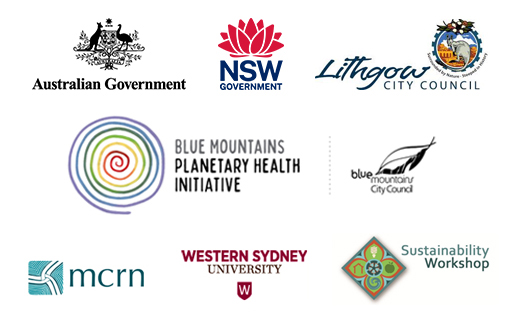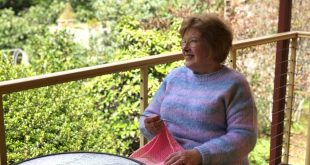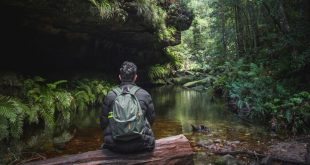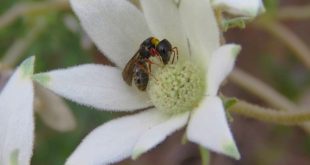Anne Mellor shares her inspiration and water management strategies. (Lis Bastian & Harry Afentoglou)
by Anne Mellor
Inspired by Japanese Zen Buddhism, Anne Mellor has designed her Springwood home around water. Facing the challenges of living in a Flame Zone, while also dealing with stormwater impacts on a sloping block, she shares how her water management strategies, including Japanese gutters and a dry creek bed, are reducing her risk of fire, flood and heatwave, while also creating a sanctuary of peace and tranquillity.
It was its location and aspect that appealed to me when I bought my property in David Road East, Springwood, eight years ago. It is a 10 minute flat walk to Springwood town centre and public transport, and the property has an unimpeded northerly aspect to the front. I knew the house and garden needed work, and I saw this as an opportunity for me to make both house and garden more accessible as I grew older, and to put into practice my view of life and living that might provide a more certain and sustainable future.
The uncertain future we face, particularly due to climate change, reminded me of the need to be as self-sufficient as possible.
The challenge of the property being in a Flame Zone meant that the management and use of on-site water needed improvement.
At the time I bought, I’d just come back from a trip to Japan. This influenced my thinking about both house and garden, and the spaces I could make within each. Like the Japanese, I was also committed to recycling as much on–site material in the garden as possible (timber, rocks, bricks etc).
Anne Mellor
With the house, I was influenced by Japanese minimalism (inspired by the aesthetic of Japan’s traditional Zen Buddhism), which focuses on keeping life simple, clean, and uncluttered, by living with just the essentials.
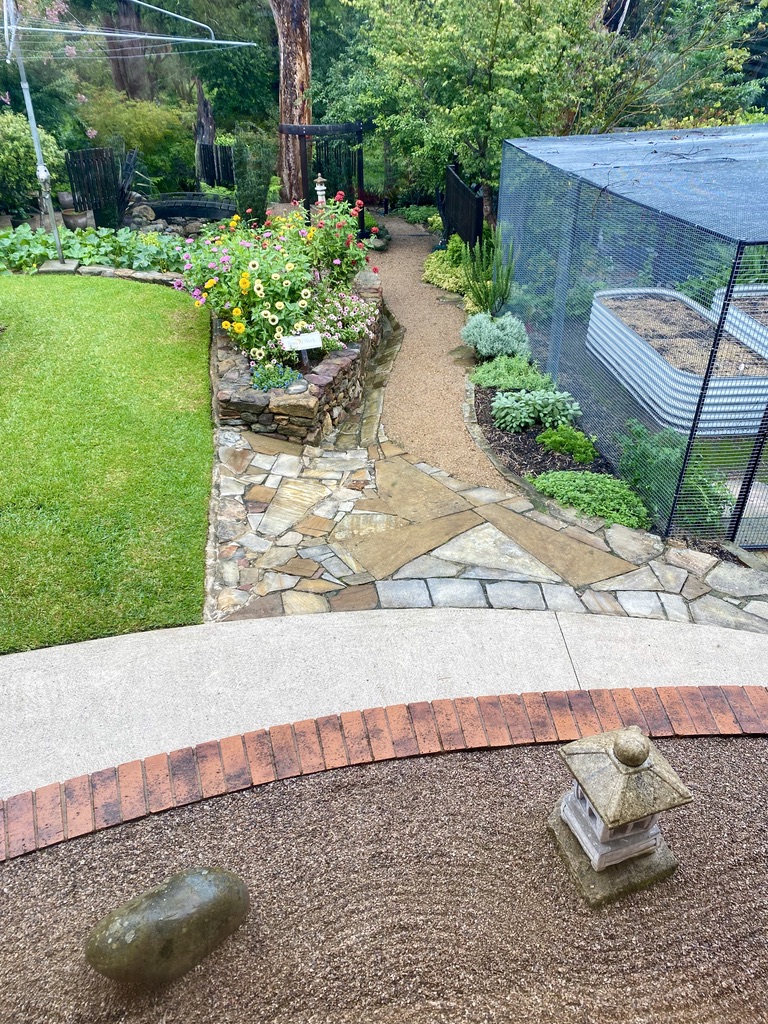
The view onto the garden from Anne’s window (Lis Bastian)
With the garden, I was influenced by the concept of a Japanese garden as a tranquil space, evoking a feeling of peace and calm for the person experiencing it. I had learnt that Japanese gardens are full of symbolism and stories. The idea was, that in my garden, I could create beautiful and safe natural spaces for contemplation and tranquillity. So, I’ve used the Zen influence, where gravel represents water. Beds of raked gravel or pebbles are arranged to remind the viewer of a flowing river or stream, with larger stones representing mountains.
A Japanese garden gate separates my back garden into two areas. Immediately behind the house is the sunny area – clothesline and vegie garden for practical living. On walking through the Japanese garden gate, one enters the somewhat hidden and mysterious part of the garden – a ‘strolling garden’ that reveals a dry creek bed as the central spine and many paths and seating areas for contemplation and calming the mind.
Sanctuaries Of Peace And Serenity
A FINE Japanese garden doesn’t make a statement; it draws the visitor into a wordless conversation. The garden doesn’t show off prized specimens; it sets a single exquisite plant off the path, on a mound of moss, next to a weathered stone. The garden doesn’t copy or improve on nature; it stylizes and miniaturizes, and sometimes even dispenses with green entirely. To the cognoscenti, each element symbolizes something larger. Ponds signify lakes. Stones represent Mount Fuji – or turtles, or cranes. Bridges denote passageways between two worlds. These allusions are drawn from Japan’s early animistic religion, Shintoism, which construes rocks and trees as dwellings of sacred spirits; from Buddhist cosmology, especially its austere tributary, Zen; and from classic Japanese literary references.
Madeline Drexler, NY Times, Sept. 29, 2002
Using Water Symbolically
I love the way in which streams and flowing water have multiple associations in the context of Japanese culture, such as cleansing, freshness, connectivity, vitality and renewal. Since time immemorial water has been considered a cleansing agent in Japan, as well as being recognised as a bringer of life.
I’ve also become aware of the Blue Spaces and the Blue health phenomenon which identifies that time spent near water is positive for health and wellbeing.
The following features of my garden have used water symbolically:
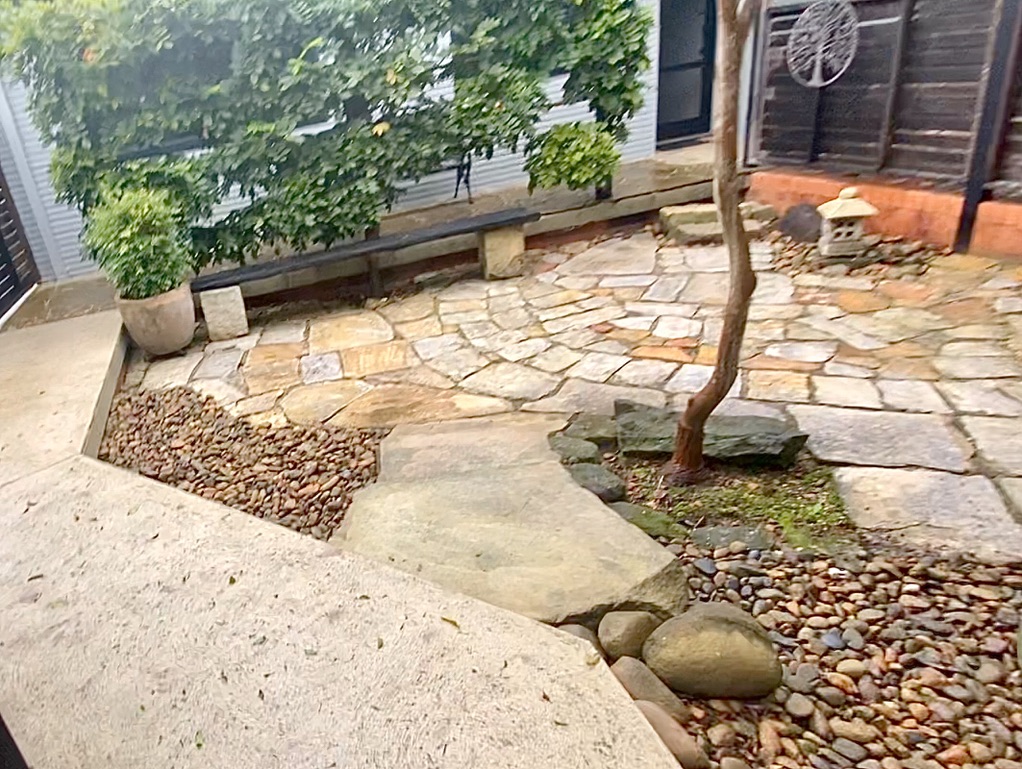
Front courtyard – pebbles represent a flowing stream. (Photo: Lis Bastian)
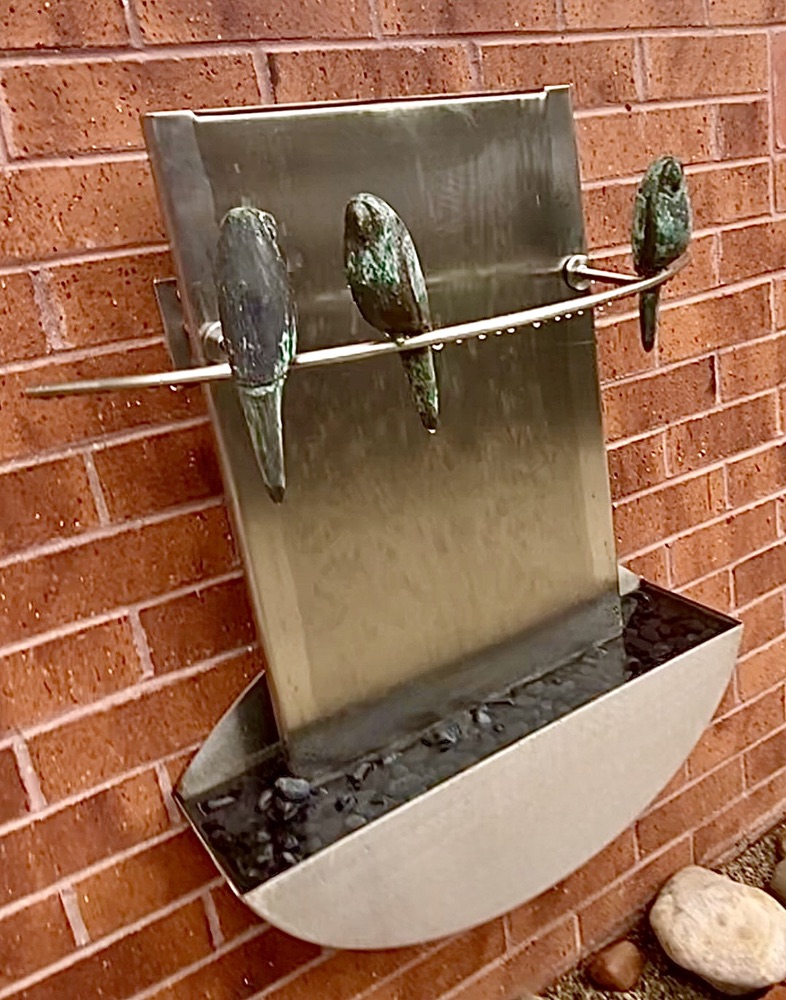
Water feature with birds – a Folco Kooper garden sculpture which re-uses water; the look and sound of gently cascading water is calming. (Photo: Lis Bastian)
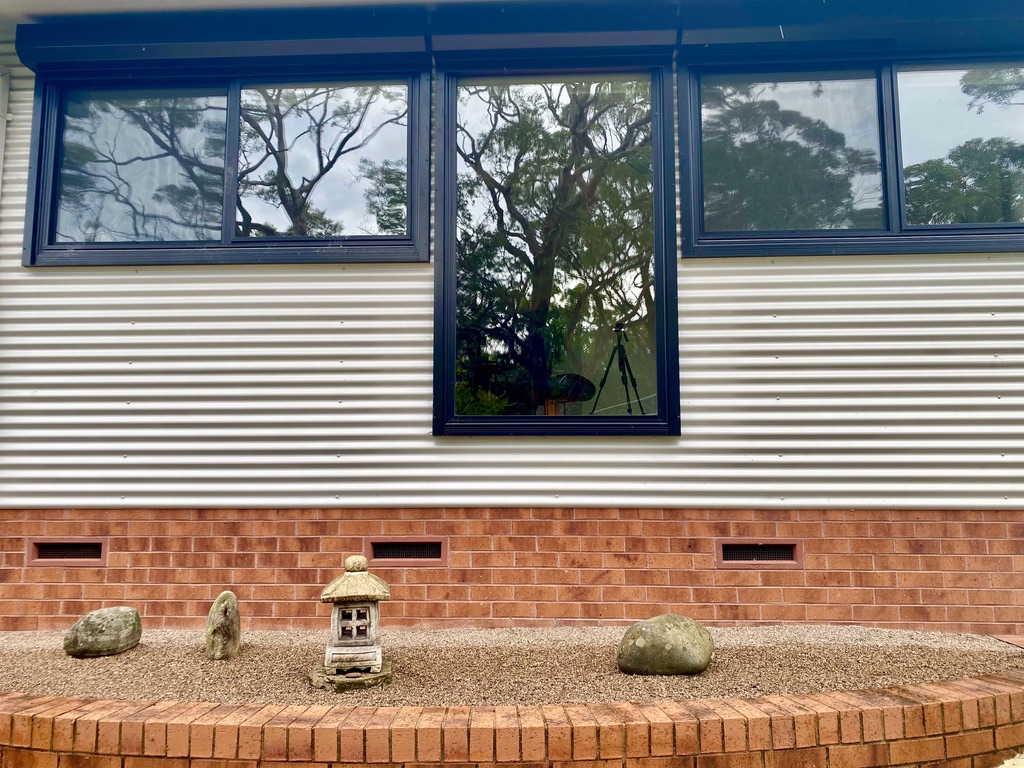
Dry landscaped garden bed immediately behind the house – raked gravel is used to represent flowing water. It also acts as a buffer to the rear of the house to reduce bushfire impact. (Photo: Lis Bastian)
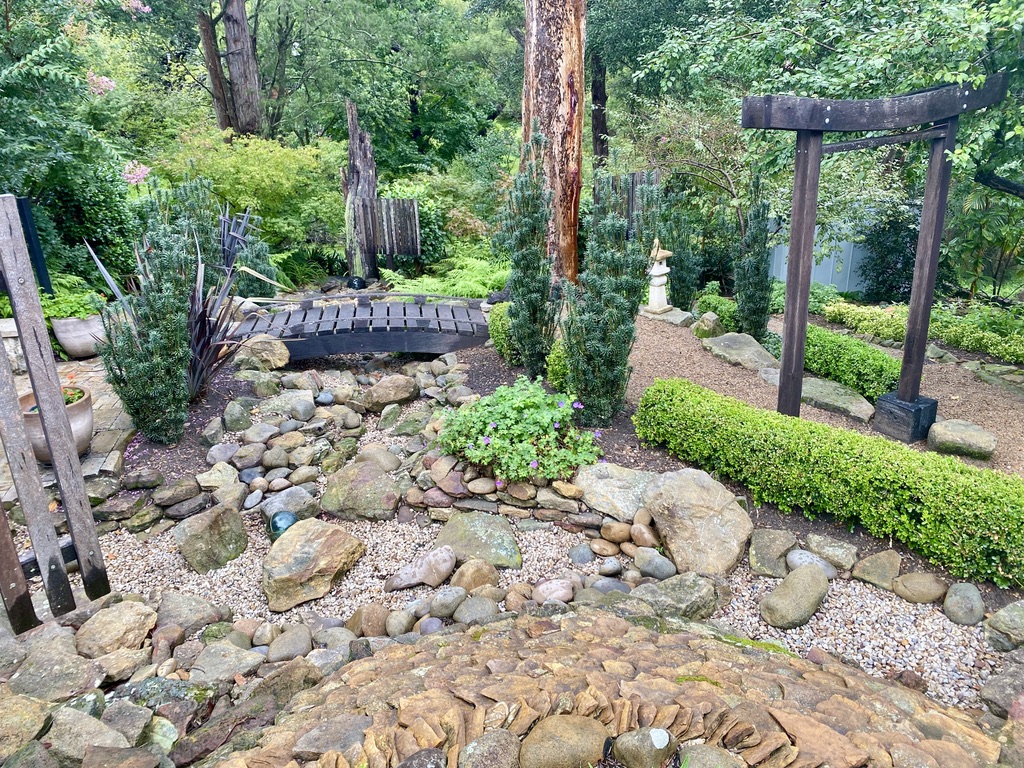
Dry creek bed with bridge – A river or creek, symbolizing the flow of life in a Japanese garden. My dry creek bed is a functional and central feature of the strolling garden design. Discrete seating spaces off the paths view the creek from different vantage points, encouraging contemplation and calm. Crossing over the bridge symbolises the journey between the mortal world into the afterlife, and the cleansing of one’s worldly burdens that follow. Through this journey, the individual experiences a symbolic sense of purity, inner peace and a unity with nature.
Glass floats for lobster pots from Seal Rocks NSW – these floats were also once used in Japanese fishing. In Japan, they are now replaced with aluminium devices. (Photo: Lis Bastian)
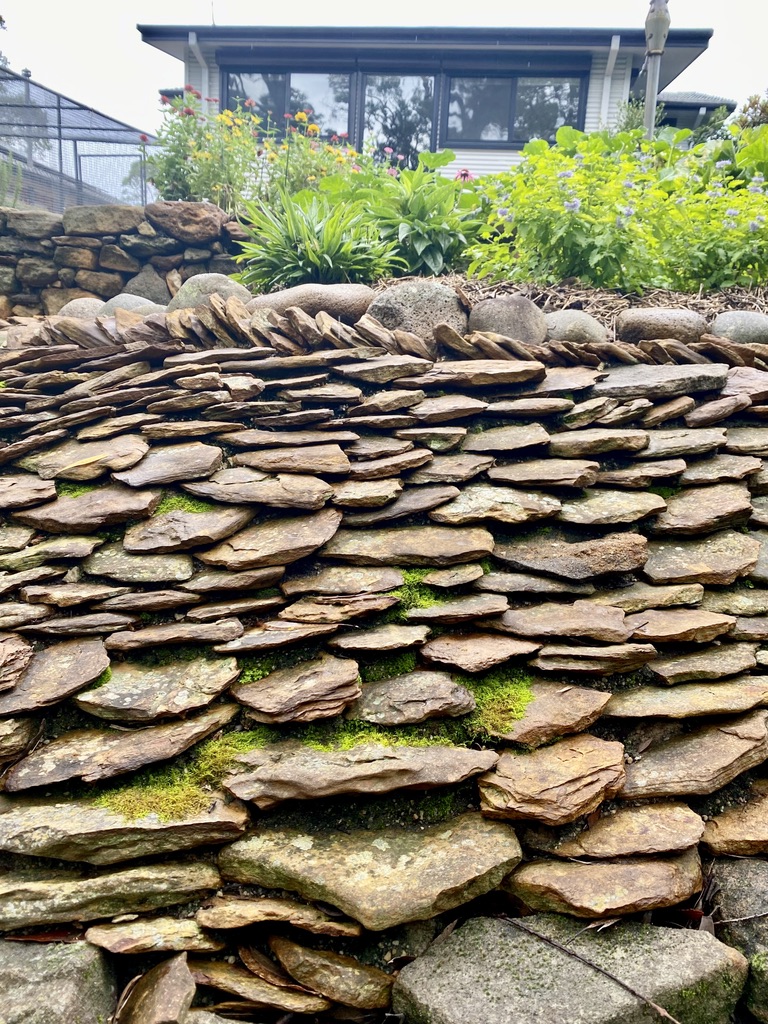
Japanese fish scale paving – Japanese fish (koi), are often associated with strength of character, perseverance, accomplishment and courage. (Photo: Lis Bastian)
Harvesting Rain Water
I’ve invested in good guttering, downpipes and stormwater drainage infrastructure.
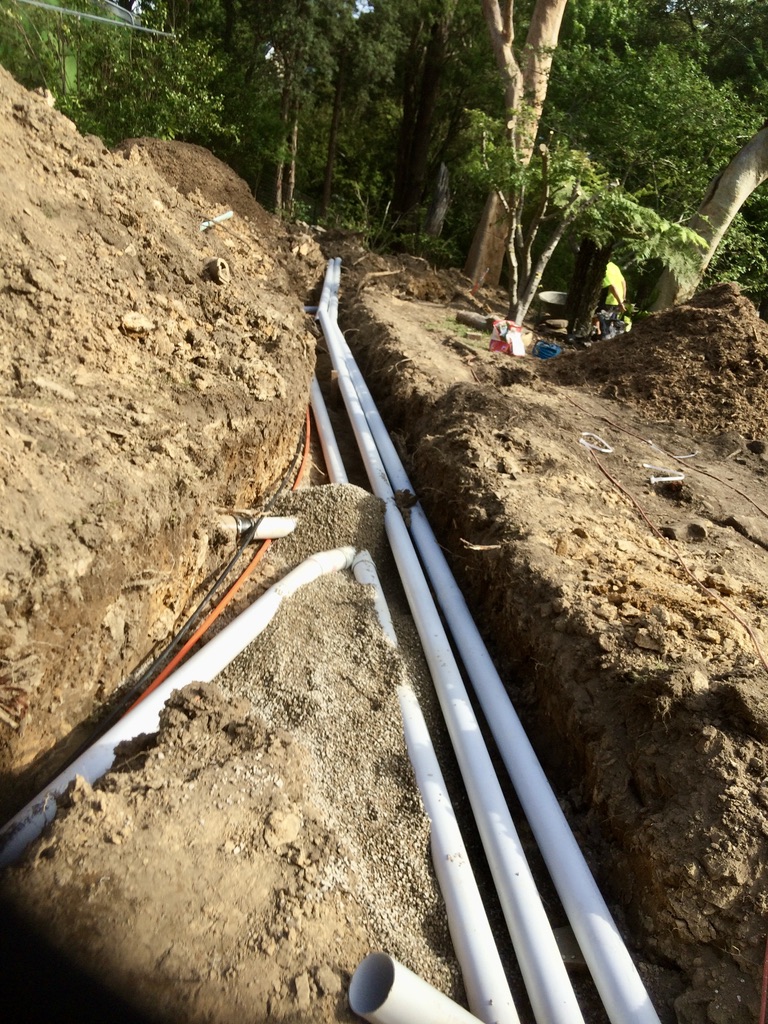
Stormwater drainage to dry creek bed (Anne Mellor)
The rain water tank under the house can hold 10,000 litres
Rain water from the main roof is captured in the tank. There is an overflow mechanism for the tank to prevent flooding under the house.
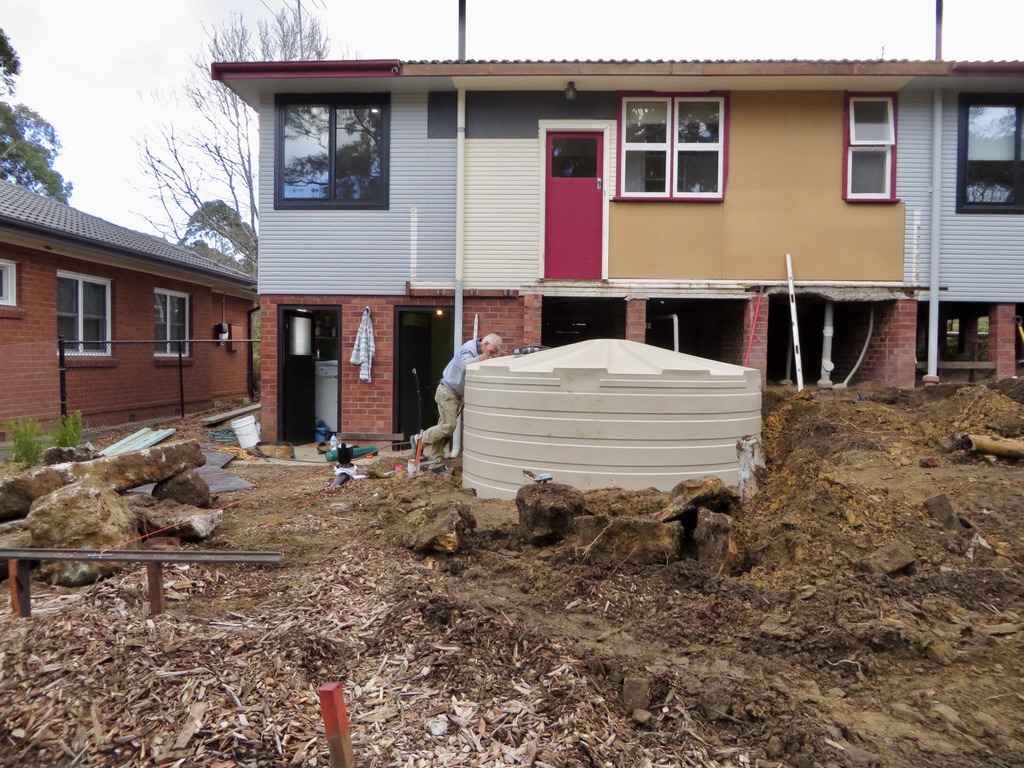
Installing the tank (Anne Mellor)
Using Rain Water from the Tank
5,000 litres from the tank is for bushfire protection. I also have a fire pump and fire hose.
The remaining 5,000 litres is for the garden via a gravity-fed watering system used for the netted vegetable garden and the citrus area.
An accessible rain water tap supplements town water if and when needed.
Managing Stormwater
The overflow from the rain water tank and other minor stormwater drainage goes into the dry creek bed infrastructure which complies with DA requirements.
The dry creek bed functions:
- Has been built to slow down stormwater preventing damage to the environment and adjoining properties – two Reln trenches are built into the drainage system
- Improves water filtration into surrounding soil and acts as a filter for weed seeds
- Aesthetics – it is a beautiful landscape feature which has become the central spine in the ‘strolling garden’ design
Dry Creek Bed design that influenced the construction of my dry creek bed.
Read more here
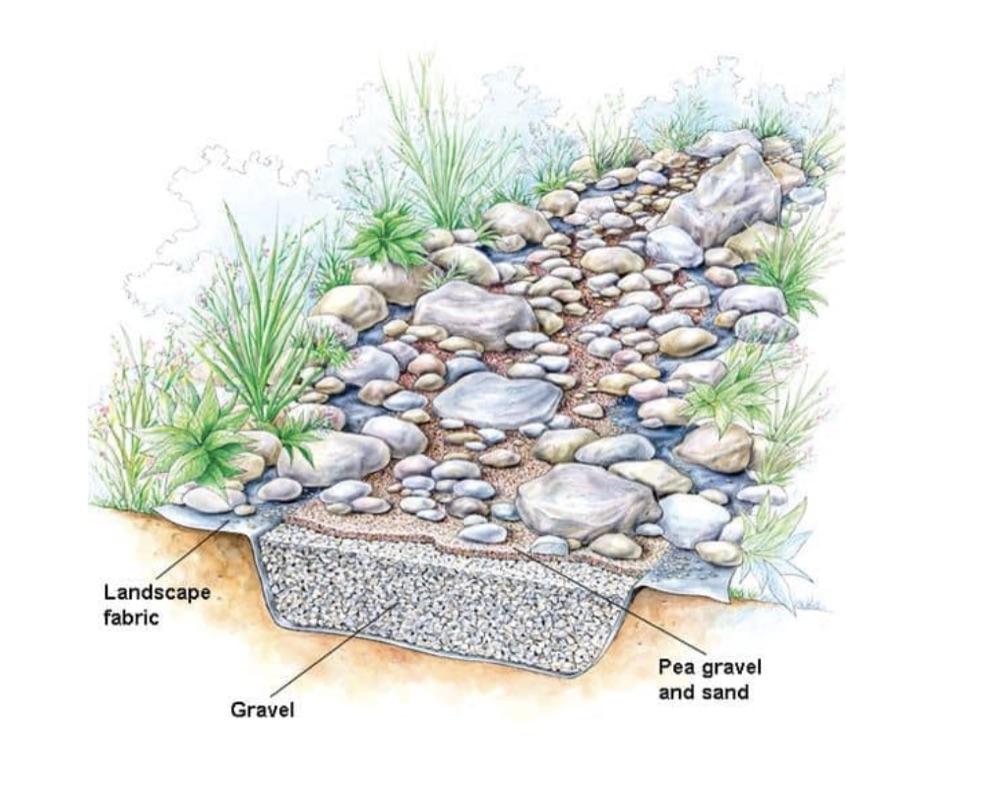
I have built two RELN Drain Trenches in the Dry Creek Bed
RELN Drain Trenching was launched in 1968 and represented a breakthrough in trenching. The range is made in Australia from strong and durable recycled plastic. It is available in three sizes to suit every soil type. They are ideal for septic effluent, sullage waste or storm water.
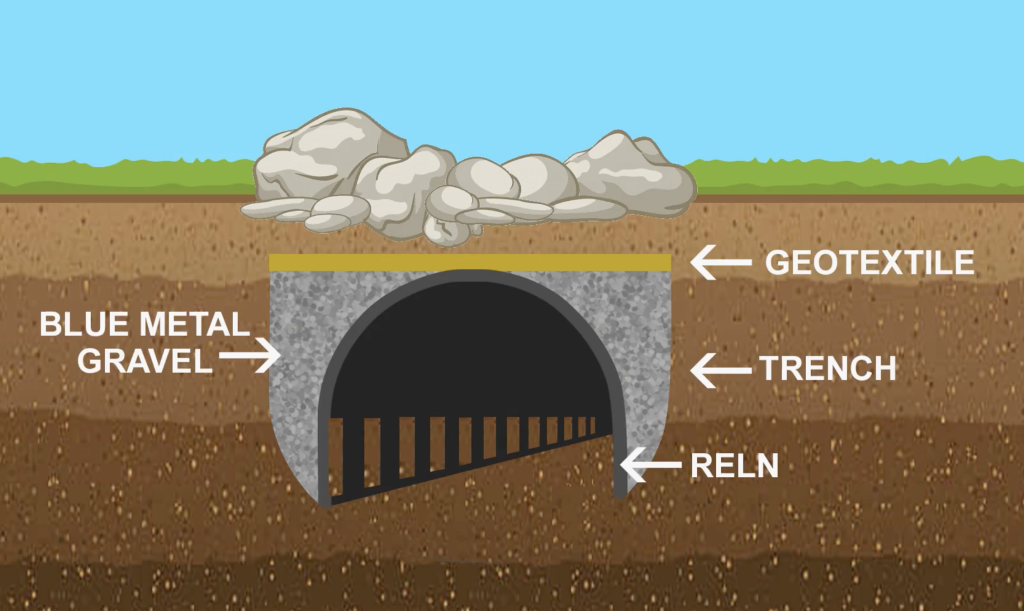
A RELN trench installed to create a dry creek bed (Graphic by Harry Afentoglou)
The dry creek bed after heavy rain:
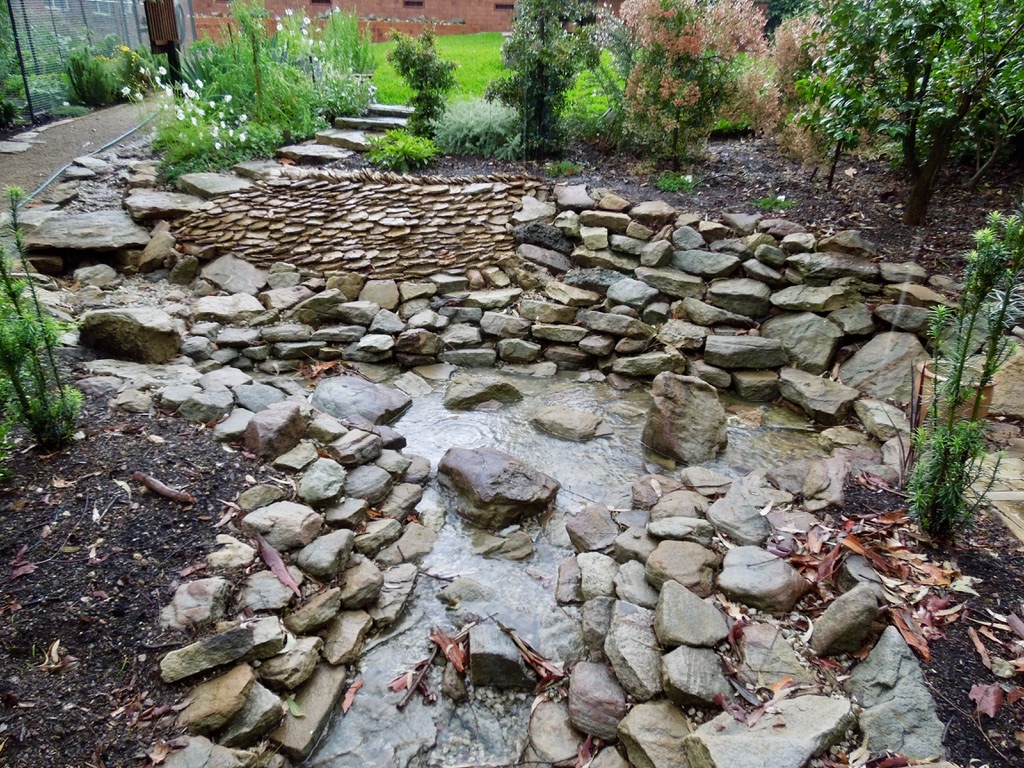
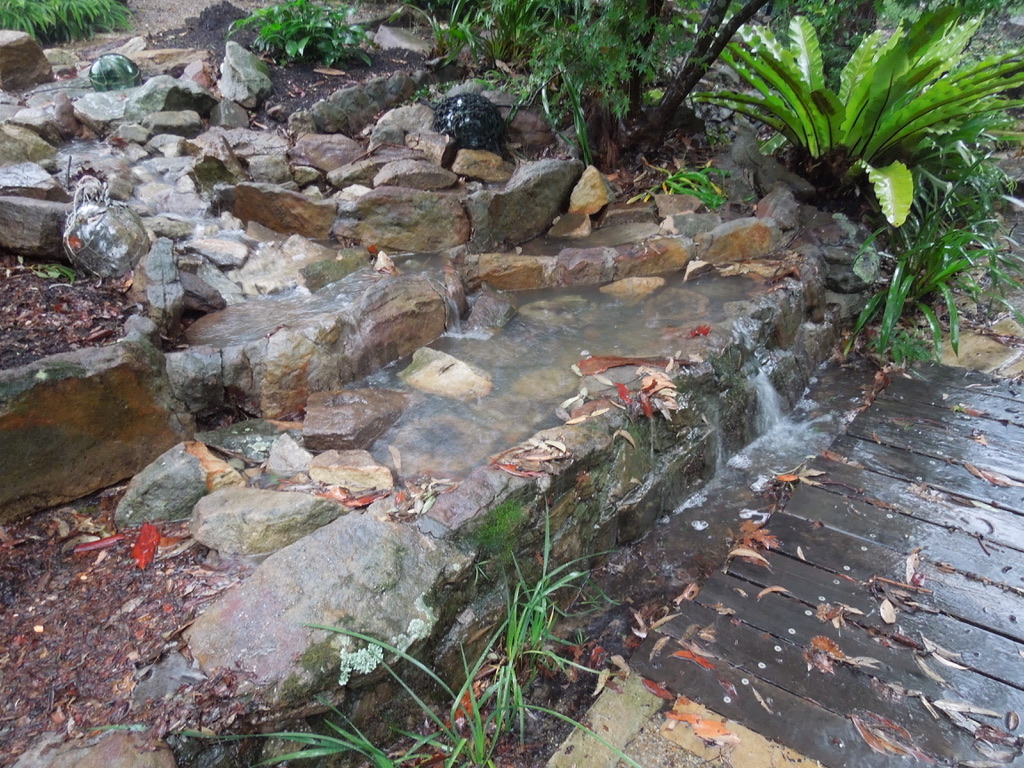
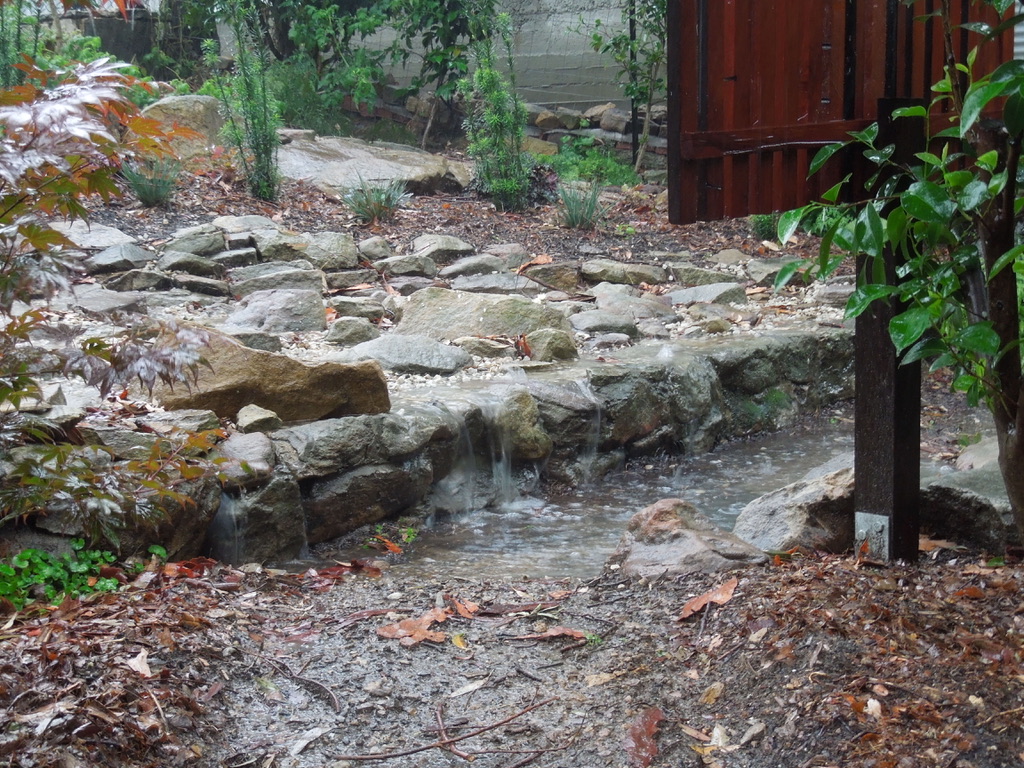
Photos by Anne Mellor
The Water Management System
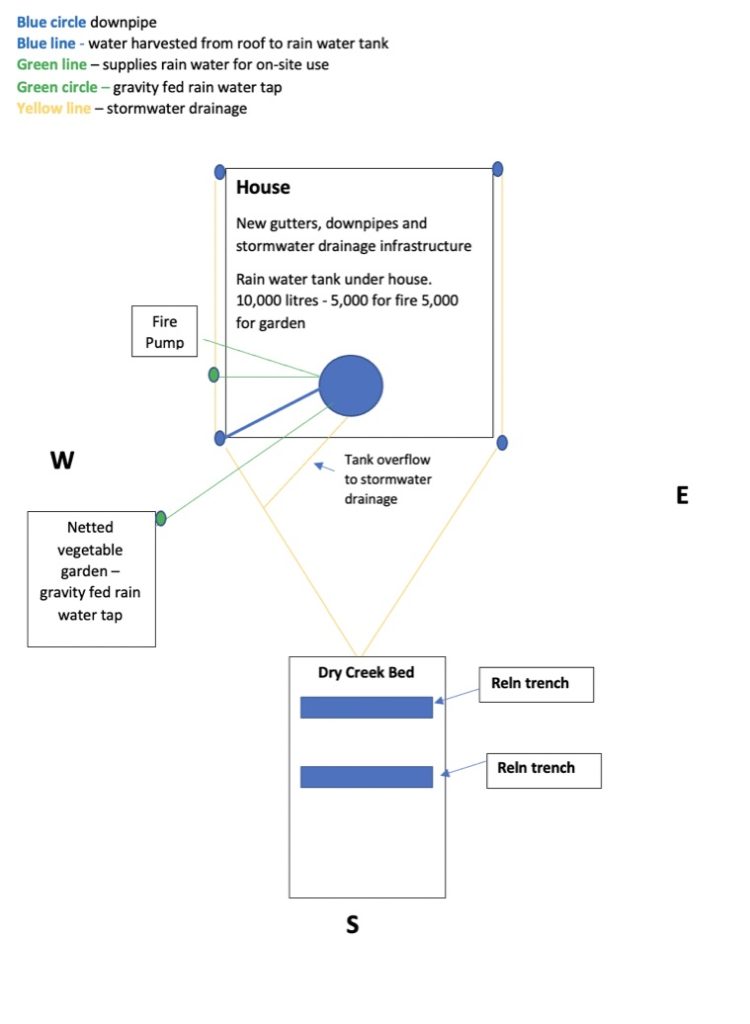
Future Proofing my Life in Springwood
Energy
- Solar panels installed.
- Rear of the house exposed to greatest bushfire risk was insulated to Flame Zone requirements. This also contributes to energy use efficiency
- I am committed to completely electrifying the house for heating and cooling using solar. Solar hot water is the only thing left to do.
Water
- Rain water tank (10,000 litres) – with accessible gravity fed rain water tap
Food
- Growing vegetables using rain water from tank / composting / worm farming
- Saving seeds – great success with pumpkins
- Seed germination – learning how to cultivate own seedlings
- Bee garden – provides bee attracting flowers all year round – increases pollination
Bushfire Protection
- Rain water tank (5,000 litres of rain water available)
- Fire pump 7HP.TWINJONO. J – key operated using a solar charged battery
- Rear of the house exposed to greatest bushfire risk was built to Flame Zone requirements in 2016
- Insulation – Rear of the house exposed to greatest bushfire risk was insulated to Flame Zone requirements.
- All windows double glazed – compliant with AS2047 2014 and AS1288 2006
- Timber on all exterior windows and fascia boards replaced with Colourbond
- BLOCKOUT shutters – compliant with relevant bushfire standards are installed on windows and door at the rear of the house exposed to greatest bushfire risk
- Gutter guard – on all gutters to reduce build-up of flammable materials in gutters
- SWS sign for front fence – yet to acquire
Mental Health
- My Garden – A Sanctuary of Peace and Serenity
Acknowledgement
To all those people who have contributed so much to my garden, especially Nick and Anders, Marinus and Dave, Lea, Indigo and Zac.
Also special thanks to Lis and Harry who came to tell the story with such love, connection, appreciation and skill.
This story has been produced as part of a Bioregional Collaboration for Planetary Health and is supported by the Disaster Risk Reduction Fund (DRRF). The DRRF is jointly funded by the Australian and New South Wales governments.
